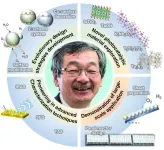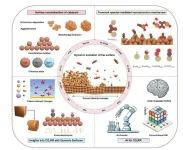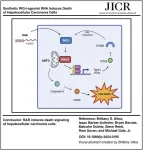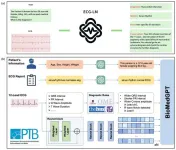(Press-News.org) Humanity can farm more food from the seas to help feed the planet while shrinking mariculture's negative impacts on biodiversity, according to new research led by the University of Michigan.
There is a catch, though: We need to be strategic about it.
"We can achieve this sustainable mariculture development," said Deqiang Ma, who led the study as a postdoctoral researcher at the U-M School for Environment and Sustainability. "With strategic planning, we can achieve the goal of conserving marine species while meeting the global demand for the expansion of mariculture."
Mariculture is the branch of aquaculture that farms saltwater seafood. In 2020, it accounted for about a fifth of the food farmed from fisheries, which is an important source of protein for billions of people worldwide.
Demand for seafood is going up and mariculture production is growing rapidly to help meet that, Ma said. To predict the impact of that growth, Ma and an international team of researchers developed a model to assess mariculture's effects on the populations of more than 20,000 species of marine fauna.
The model allowed the team to establish a baseline for mariculture's current impacts and forecast how those would change by 2050 under a range of scenarios, depending on, for instance, what was farmed where. The model also looked at two different climate scenarios, known as RCP 4.5 and 8.5, assuming different levels of warming and greenhouse gas emissions.
The best-case scenario—building the most farm capacity in the areas with the lowest environmental impact—produced exciting numbers for both bivalve shellfish and "true" fish, or finfish.
"Bivalve production could increase by 2.36-fold and finfish could increase by 1.82-fold compared to current production—projections of what is needed to meet global demand—but the global mariculture impacts would decrease by up to 30.5% under the best-case scenario," Ma said.
On the flipside, the worst-case scenario was also striking. If new farms are built in the areas that would have the most detrimental impact on biodiversity, it would be over four times worse than building them at random sites.
This underscores the importance of strategic planning, said U-M senior study author Neil Carter, and of working with experts from a variety of fields who can assess a wide range of considerations.
"It is critically important to leverage the growing insights across disciplines, whether it's climate change science or economics or marine production," said Carter, associate professor of environment and sustainability. "All these different facets had to come together from other sources in order to make these forecasts."
The team included researchers from the University of Washington, the University of Freiburg in Germany, Hokkaido University in Japan and the University of California, Santa Barbara.
The scope of the analysis and the collaboration required to perform it can create challenges for projects like this, said study co-author Benjamin Halpern, a professor at UCSB.
"But I've done this kind of work a lot in my career, and the payoffs can be enormous," said Halpern, who is also the director of the National Center for Ecological Analysis and Synthesis. "The cross-disciplinary nature of the questions that can be addressed and the ability to look at them for every patch of ocean in the world makes the research much more relevant and impactful to society and the scientific community."
Ma and Carter stressed that the paper is a first step toward building mariculture's most sustainable future. Scientifically speaking, the model can be refined by including more and newer data moving forward.
The research also showed there isn't a one-size-fits-all solution to grow mariculture sustainably. From a research standpoint, the opportunities for farm development are different in the South Pacific than they are along the coast of France.
And the decisions made to work toward the world's best-case scenario can still have drawbacks. Developing mariculture had a negative impact on important and iconic marine mammals—including whales, seals and sea lions—in all the scenarios analyzed by the team.
But understanding these limitations and trade-offs helps researchers and policymakers better anticipate the impacts of important decisions before they are made.
"With these insights, we can see that it's not a foregone conclusion that the expansion of an industry is always going to have a proportionally negative impact on the environment," Carter said. "So the next part of this is getting policymakers and communities to interact with each other to figure out how we can actually implement some of these ideas to reduce those impacts and to prioritize marine biodiversity."
The project was funded by the U-M School for Environment and Sustainability and the U-M Institute for Global Change Biology.
END
We can farm more seafood while minimizing its impact on biodiversity, U-M research shows
2025-02-19
ELSE PRESS RELEASES FROM THIS DATE:
Professor Kazunari Domen: Groundbreaking contributions to photocatalytic water splitting
2025-02-19
Harnessing solar energy to produce hydrogen from water – the photocatalytic water splitting reaction, is a promising approach for the carbon-neutrality future. This process utilizes semiconductor materials to harvest sunlight for the splitting of water into hydrogen fuel with oxygen gas generated as by-product. The solar hydrogen, as a carbon-free energy source, holds immense potential for decarbonizing industries, addressing global energy demands and mitigating environmental challenges. However, realizing practical ...
Electrochemical carbon dioxide reduction: Dynamic surfaces of Cu-based catalysts
2025-02-19
The continued massive consumption of fossil fuels in modern societies has led to a range of environmental issues, including excessive CO2 emissions. In this regard, electrochemical CO2 reduction can convert intermittent electricity into chemical fuels and other value-added products, which holds the potential to close the carbon cycle. Among the various catalysts, metals are the most extensively studied heterogeneous CO2RR electrocatalysts and can be classified into three categories based on the main products. Containing Bi, ...
Synthetic RIG-I-agonist RNA induces death of hepatocellular carcinoma cells
2025-02-19
New Rochelle, NY, February 19, 2025—A new study in the peer-reviewed Journal of Interferon & Cytokine Research (JICR) showed that a specific retinoic acid-inducible gene I (RIG-I) agonist RNA (RAR) induces innate immune signaling and death of hepatocellular carcinoma cells in vitro. Click here to read the article now.
Michael Gale, Jr., from the University of Washington School of Medicine, and coauthors, evaluated the actions of a specific RIG-I agonist RNA against two distinct human hepatocellular carcinoma cell lines. RAR is a synthetic-modified ...
Registration now open for CMSC Annual Meeting in Phoenix, AZ
2025-02-19
The Consortium of Multiple Sclerosis Centers (CMSC) is pleased to announce that registration is now open for its Annual Meeting, taking place May 28-31, 2025 in Phoenix, Arizona. This premier event is designed to provide healthcare professionals with the latest practical care strategies and scientific advancements in the field of multiple sclerosis and other CNS inflammatory conditions.
The CMSC Annual Meeting brings together leading MS specialists, researchers, and healthcare clinicians for a dynamic program featuring cutting-edge research, innovative treatment approaches, and interactive courses. Attendees will have the opportunity ...
Breakthrough in heart health: A new approach to interpreting ECG data using large language models
2025-02-19
A team of researchers from Tsinghua University and Beijing Tsinghua Changgung Hospital has introduced a cutting-edge method to improve the interpretation of electrocardiogram (ECG) data. Their innovative model, called ECG-LM, leverages the power of large language models (LLMs) to interpret complex ECG signals more effectively and accurately. The groundbreaking research was published in Health Data Science, offering a transformative approach that promises to revolutionize heart-related diagnostics.
Electrocardiograms ...
Illicit substance use and treatment access among adults experiencing homelessness
2025-02-19
About The Study: In a representative study of adults experiencing homelessness in California, there was a high proportion of current drug use, history of overdose, and unmet need for treatment. Improving access to treatment tailored to the needs of people experiencing homelessness could improve outcomes.
Corresponding Author: To contact the corresponding author, Ryan D. Assaf, PhD, MPH, email ryan.assaf@ucsf.edu.
To access the embargoed study: Visit our For The Media website at this link https://media.jamanetwork.com/
(doi:10.1001/jama.2024.27922)
Editor’s Note: Please see the article for additional information, including other authors, ...
Predicting diagnostic progression to schizophrenia or bipolar disorder via machine learning
2025-02-19
About The Study: The findings of this study suggest that it is possible to predict diagnostic transition to schizophrenia and bipolar disorder from routine clinical data extracted from electronic health records, with schizophrenia being notably easier to predict than bipolar disorder.
Corresponding Author: To contact the corresponding author, Lasse Hansen, MSc, PhD, email lasse.hansen@clin.au.dk.
To access the embargoed study: Visit our For The Media website at this link https://media.jamanetwork.com/
(10.1001/jamapsychiatry.2024.4702)
Editor’s Note: Please see the article for additional information, including other authors, author contributions ...
U.S. facing critical hospital bed shortage by 2032
2025-02-19
U.S. hospital occupancy after the end of the Covid-19 pandemic is significantly higher than it was before the pandemic, setting the stage for a hospital bed shortage as early as 2032, new research suggests.
In the decade leading up to the pandemic, U.S. average hospital occupancy was approximately 64%. In a study to be published in the peer-reviewed journal JAMA Network Open, the team of UCLA researchers found that the new post-pandemic national hospital occupancy average is 75% -- a full 11 percentage points ...
Health care staffing shortages and potential national hospital bed shortage
2025-02-19
About The Study: The U.S. has achieved a new post-pandemic hospital occupancy steady state 11 percentage points higher than it was pre-pandemic. This persistently elevated occupancy appears to be driven by a 16% reduction in the number of staffed U.S. hospital beds rather than by a change in the number of hospitalizations. Experts in developed countries have posited that a national hospital occupancy of 85% constitutes a hospital bed shortage (a conservative estimate). The findings of the current study show that the U.S. could reach this dangerous threshold as soon as 2032, with some ...
Long-term outcomes of laparoscopic Roux-en-Y gastric bypass vs laparoscopic sleeve gastrectomy for obesity
2025-02-19
About The Study: After more than 10 years of follow-up in the Swiss Multicenter Bypass or Sleeve Study randomized clinical trial, Roux-en-Y gastric bypass demonstrated superiority over sleeve gastrectomy for patient excess body mass index loss.
Corresponding Author: To contact the corresponding author, Ralph Peterli, MD, email ralph.peterli@clarunis.ch.
To access the embargoed study: Visit our For The Media website at this link https://media.jamanetwork.com/
(doi:10.1001/jamasurg.2024.7052)
Editor’s Note: Please see the article for additional information, including other authors, author ...




